Your CEO Doesn’t Have to Post His Own Articles to Be Effective on LinkedIn
— August 9, 2019
Is 2019 the year of the social CEO?
I wrote about this trend in my recent 2019 trends presentation. And, I’ve noticed a few more prominent CEOs taking a more active stance in social recently. Shelly Ibach, CEO and president of Sleep Number (client) comes to mind.
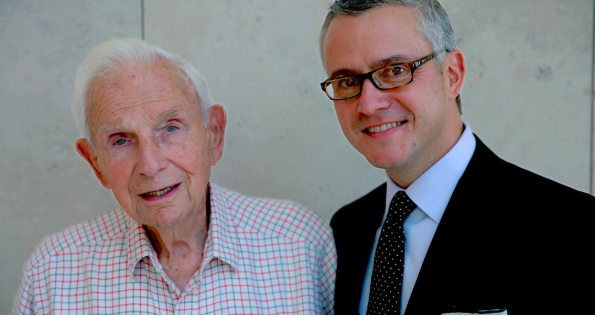
In many of these situations, CEOs start on social because they want to build thought leadership–for them, and the brand. So, they share articles they have authored. They share articles where they have been featured in the media. In general, they’re mostly sharing content either they have authored or content where they are prominently featured. And, if the goal is thought leadership and brand-building, that makes a ton of sense.
But, it’s not the only way to go about it.
There is a more well-rounded approach that a few CEOs are taking that I think is very interesting. And, it has more to do with community-building than it does thought leadership.
One CEO who is doing this well at the moment if H&R Block’s Jeff Jones.
For Minnesotans, you might recall Jeff is the former CMO of Target. And, in that role, he had a fairly famous post on LinkedIn during the Target financial crisis years ago (I wrote about it here, if you’re interested). So, Jeff’s been on my radar for years.
But, his most recent activity on LinkedIn caught my eye. Not because he was active on LinkedIn–it was the WAY in which he was active that really intrigued me.
To cut to the chase: Jeff seems to spend more time liking and commenting on other content than he does creating and sharing his own. And it’s a brilliant strategy.
First, what is he doing? Jeff is actively commenting on a variety of content–mostly that produced by the corporate H&R Block account, like this post.
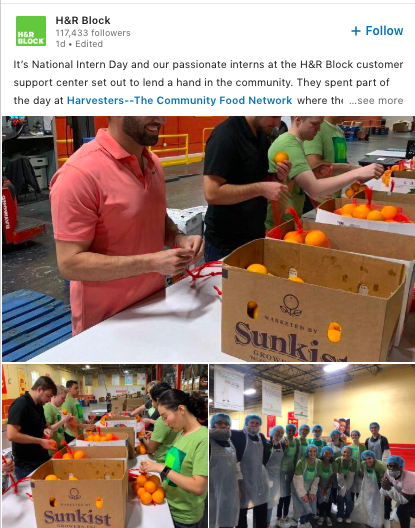
And, here’s Jeff’s comment on the post–as you can see, nothing too complicated:
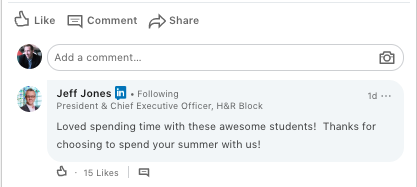
He also frequently comments on H&R Block employee posts like this one:
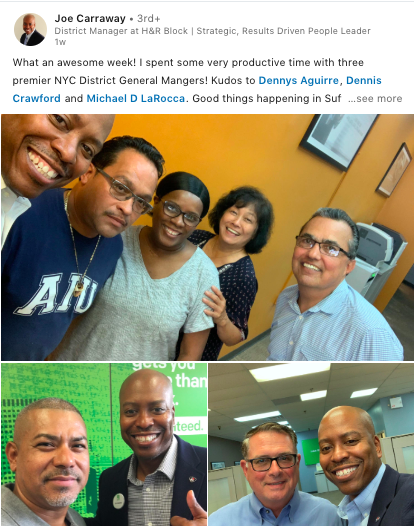
Again, here’s Jeff’s simple comment:

And finally, he’s re-sharing other H&R Block employee content, when it makes sense:
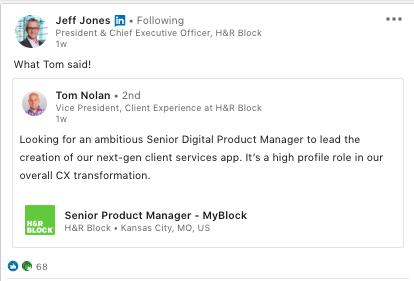
Not to mention, Jeff “likes” a variety of content on LinkedIn from H&R Block posts to employee posts to general news posts.
Why is this a brilliant strategy?
One big reason.
Imagine you’re Joe, the HRB district manager from the post above. You make a simple post on LinkedIn celebrating your week. You see a few comments and feel good about the post. Then, THE CEO OF YOUR FREAKING COMPANY comments on the post saying how much he loves it. Think about the impact that had on Joe. Think about the pride he feels in working for a big company where the CEO takes the time to comment on his post. Then, think about all the other people that saw Jeff comment on that post. Employees, prospective employees, vendors, customers. They all saw a CEO of a large company take the time to recognize and comment on a single employee’s post. Now, take that same example and apply it to vendors, or customers.
That’s leadership. That’s building culture. It impacts recruiting. It impacts employee retention. It probably even impacts customer acquisition, in a seven-degrees-of-separation type way.
Now, think about the time it takes Jeff to do this each day (assuming he has no help, which he probably does). I’m guessing it’s about 5-10 minutes at most. Time to scan LinkedIn quickly (again, some of this stuff is probably flagged for him). Time to leave a short comment. Time to “like.” That’s 5 minutes every few days–5 minutes that can have an enormous impact on the brand.
Now, measurement is the tricky thing here. How do you measure what kind of impact all this liking and commenting has on the HRB brand? That’s no easy task. And, I’m not sure I have a great answer. But, there are some lagging indicators you could look at:
- Glassdoor CEO approval ratings. This is the kind of stuff that impacts those ratings (not coincidentally, Jeff has an approval rating of 74% on Glassdoor). Sure, all sorts of stuff internally at HRB would impact that ranking, too. But, this kind of public-facing commenting on LinkedIn would work into it, too.
- Internal surveys. Why couldn’t you bake a question or two into your next employee survey about your CEO’s actions on LinkedIn? I wonder if HRB does this with Jeff (if not, they should!). Easy way to see if and how employees’ perceptions are changed by his engagement on social media.
- Engagement on Jeff’s engagement. Look back at the HRB intern post above. Jeff’s comment generated 15 likes. That’s a pretty good indicator of sentiment given how the post performed overall.
Want a more local version of what this looks like here in MSP? Look no further than Dave Schneider, CMO of Red Wing Shoes. Now, Dave’s not the CEO (yet–see Jeff Jones career path), but he is on the C-suite with a major Minnesota brand. And, he’s taking a similar approach to Jeff.
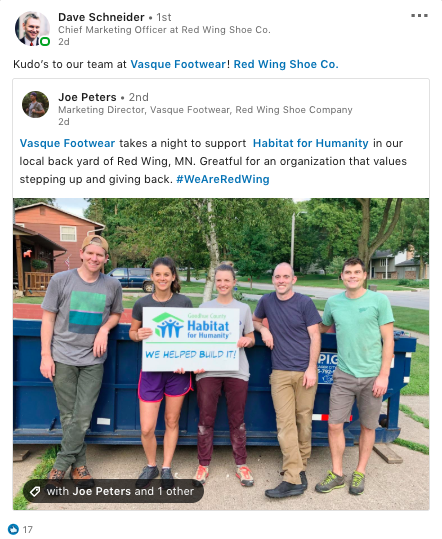
Dave regularly recognizes Red Wing Shoe employees for their work (and volunteering efforts, in this case).
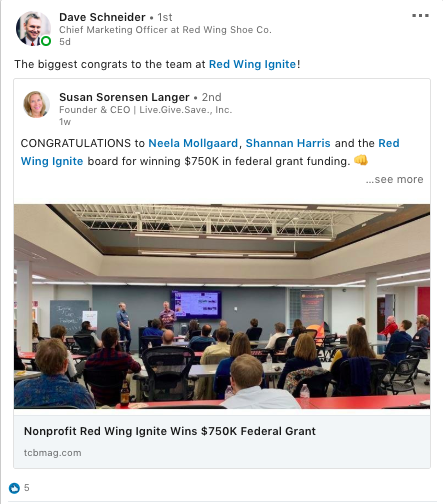
He’s also a regular commenter on all sorts of posts–including those highlighting other marketing/communications leaders in Minnesota. Case in point: This post featuring CLR’s Julie Batliner.
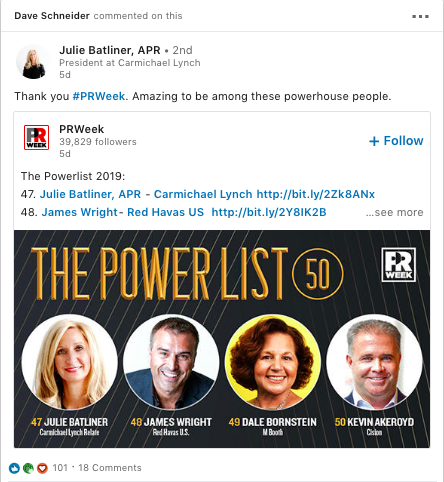
The point of all this: There’s more than one way to get your executives more active on LinkedIn. It doesn’t need to be all about them. It doesn’t need to be all about thought leadership. A more community-focused approach can be the perfect strategy with the right leader and the right situation.
Digital & Social Articles on Business 2 Community
(32)

